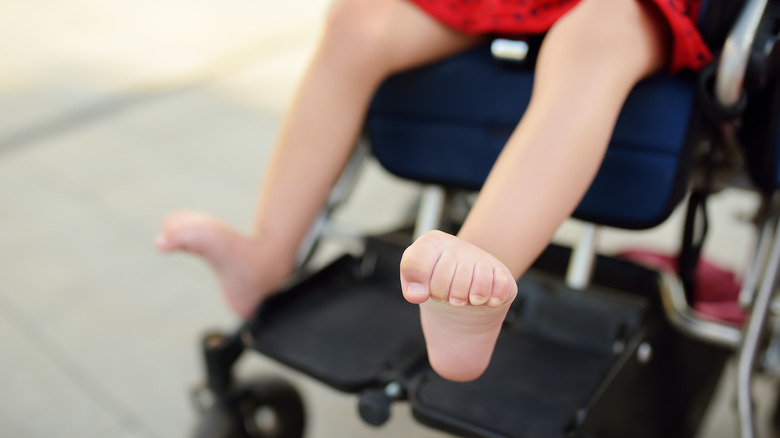How To Live With And Treat Spasticity
According to WebMD, spasticity is a painful condition that causes tight and stiff muscles. The term "spasticity" originates from the Greek word "spasticus," which means "to pull or to tug," as revealed in this 2013 study published in the Saudi Journal of Anaesthesia. The condition affects 12 million people worldwide, and the symptoms of spasticity vary based on numerous factors, according to Johns Hopkins Medicine. While some people may be severely affected, requiring immediate assistance, others may experience mild symptoms.
Visiting your doctor is the first point of call if you notice specific spasticity symptoms. According to Healthline, people with spasticity are usually under the care of a neurologist. Treatment mostly involves reducing the severity of the symptoms to improve their quality of life, per the Cleveland Clinic. Before we delve into the different treatment options for the condition, it's important to understand the various causes and symptoms of spasticity.
What causes spasticity?
Spasticity is caused by damage in the body's nerve cells (known as neurons), which are responsible for transmitting information to the brain and the nervous system (via Cleveland Clinic). This damage disrupts muscle movement patterns, causing some muscles to contract when moving or resting. The condition is especially common among people with multiple sclerosis (MS) and cerebral palsy. The National Institute of Neurological Disorders and Stroke defines multiple sclerosis as an unpredictable autoimmune disease of the central nervous system that disrupts communication between the brain and the body. According to the MS Society, about 40% to 80% of multiple sclerosis patients experience spasticity.
Spasticity in people with cerebral palsy is caused by an injury to the motor cortex of the brain, which can happen during or after birth. It can affect the lower limbs and speech abilities, per the Cerebral Palsy Alliance.
Spinal cord injuries can also cause spasticity. The World Health Organization estimates between 250,000 to 500,000 people suffer a spinal cord injury annually, often due to road traffic crashes, falls, or violence. The spinal cord can become areflexic immediately after the injury, and patients may experience muscle paralysis and flaccid muscle tone, according to a 2010 study published in the journal Neurorehabilitation and Neural Repair. These immediate symptoms give way to spasticity, which develops gradually, sometimes weeks after the spinal cord injury.
Symptoms of spasticity
Pain and muscle tightness are common among people who experience spasticity, making it difficult to perform simple tasks, says the American Association of Neurological Surgeons. These symptoms can cause painful muscle contractions and movements to be less precise. According to Healthline, general muscle contractions can make it difficult to walk. Some people may experience effects beyond pain and discomfort. This includes the involuntary crossing of your legs, an abnormal posture, and contracture (permanent stiffness or contraction of a muscle), per the Cleveland Clinic.
Besides these general symptoms, spasticity can lead to more severe symptoms, like frozen joints and pressure sores. Other more severe symptoms include pressure sores, which can lead to life-threatening symptoms like blood poisoning or gangrene, despite usually only requiring minor nursing care, per the National Health Service (NHS). Nevertheless, some symptoms of spasticity require effective diagnosis and treatment. If left untreated, moderate to severe spasticity can lead to partial or full dislocation of the joints, chronic constipation, and urinary tract infections (via the Cleveland Clinic).
How is spasticity diagnosed?
According to a 2019 study published in the journal Current Neurology and Neuroscience Report, the wide variety of symptoms in people with spasticity has made assessing the condition difficult. Clinical evaluation usually starts with understanding the location, severity, frequency, and duration of spasticity, per the study. Besides the physical examination, a numerological assessment of your muscle tone and stretch reflexes might also be needed. This is especially needed in people suspected to have multiple sclerosis, according to the study. The source also indicates that most tools used to assess spasticity have become less effective in diagnosing spastic symptoms. However, continuous improvement in the understanding of spasticity may support the development of new, more effective diagnostic tools.
Due to the link between spasticity and other conditions, a neurologist might inquire about neurological or muscular disorders in your family to make a proper diagnosis, according to WebMD. Multiple tests might be made to assess your limb movements, muscular activity, range of motion, and general ability to perform everyday activities.
How to live with and treat spasticity
Spasticity has no cure, but certain treatments are available to ease symptoms (via the Spastic Paraplegia Foundation). They range from over-the-counter drugs to surgical and non-surgical remedies. Muscle relaxants, such as baclofen, dantrolene sodium, and tizanidine, may also be prescribed, according to WebMD. These drugs sometimes come with side effects, such as drowsiness, dizziness, weakness, confusion, and upset stomach.
In some cases, doctors recommend neurosurgery or orthopedic surgery, which involves operating on bones, muscles, and connective tissues to aid movements. Some doctors also recommend intrathecal baclofen therapy (ITB), which involves the implantation of a pump in your belly to transport liquid baclofen to your spinal cord, per WebMD. The latter works better than swallowing pills and it saves you from the side effects associated with spasticity medications.
Physical therapy might not eliminate spasticity, but it may help reduce the intensity of the symptoms (via Healthline). Your therapist might develop a treatment program to improve strength and mobility in the affected areas, helping you reduce muscle tension and function independently. A full-proof physio plan for spasticity may include methods like cryotherapy, low-level laser therapy, electric stimulation, or orthotics to improve joint mobility. However, the impact of your plan will depend on your physio goals and the severity of your spastic symptoms.
When to see a doctor for spasticity
According to the American Association of Neurological Surgeons, it's important to see a doctor when you experience spasticity for the first time or if symptoms worsen after a diagnosis. The association also advises seeking medical care when the pain becomes severe and curtails your ability to perform everyday tasks. Although diagnosis and treatment usually begin with a trip to your doctor, various health professionals are more qualified to deal with neurological conditions associated with spasticity.
According to Healthline, you might first be transferred to a neurologist, who'll diagnose the underlying cause of your spasticity and guide the treatment. Also, physical, speech, and occupational therapists can play essential roles in managing spasticity symptoms. You might be advised to join support groups that help you connect with other people with the condition (via Healthline). Caregivers may be enlisted to help, especially if spasticity symptoms become severe, making patients unable to handle simple self-care activities.






